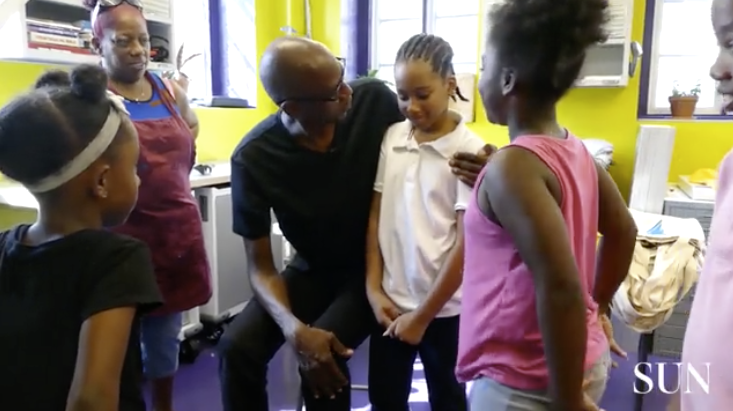
Artist Mark Bradford and BMA have launched a project with the community group Greenmount West for at-risk kids to learn silk screening skills they can use to make and sell T-shirts, baseball caps, and other items of clothing. (Kenneth K. Lam, Baltimore Sun video)
Artist Mark Bradford visited Baltimore a few days ago. While in town for the opening of his most recent exhibition, Mark Bradford: Tomorrow is Another Day at the Baltimore Museum of Art, he made sure to visit the Greenmount West Community Center. It was not his first time there either; the artist has a longstanding relationship with the center. He’s responsible for the purchase of a four-color press, a flash dryer, an exposure unit, and computers and equipment that helps provide weekly silk-screening workshops for youths ages 5 to 18. The classes began in March and have now abled the production of enough merchandise to open a pop-up store at the museum, which launched last week. The Greenmount Power Press, as the project is called, is a collaboration between Bradford, the Baltimore Museum of Art, the community center and a grassroots organization called Noisy Tenants.
Bradford, whose work centers on transforming materials scavenged from the street into wall-sized collages and installations—with a special interest in impromptu networks and underground economies—is known for launching social service programs in cities where his work is exhibited. He founded a community arts center in his native Los Angeles that works with young people in foster care, and also set up a storefront in Venice, Italy as part of the 2017 Venice Biennale where former inmates could sell products they crafted while in prison. “Centers like these create safe spaces that young people can come to and feel protected. And once they feel protected they can develop their creativity” he told The Baltimore Sun. “These types of spaces that are embedded in the community are very important. Because when you embed them in the community, when children don’t have to leave to find art, it doesn’t make it so out of reach.”
This Week in Art
- BRIC is presenting a new large-scale installation by Mary Mattingly, featuring sculpture, photography, and a monumental wall-based flow chart, that poses the question: What happens when an object that embodies both the systemic violence represented by war and by climate change is manifested in a public space? Mary Mattingly: What Happens After? is curated by Jenny Gerow and will be on view through November 11, 2018.
- A new exhibition of Brazilian artist Lygia Pape’s work has opened at Hauser and Wirth in New York. Following Pape’s retrospective at the Met Breuer last year, this show focuses the artist’s early Desenhos, Tecelares and later, iconic Ttéia installations. On view through November 19.
- Kara Walker: Virginia’s Lynch Mob and Other Works recently opened at the Montclair Art Museum in New Jersey, where it will be on view through January 6, 2019. The show seeks to contextualize Walker‘s monumental wall installation Virginia’s Lynch Mob, a recent major acquisition.
- Lari Pittman’s Portraits of Textiles & Portraits of Humans will be on view through October 27 at Regen Projects in Los Angeles. The show presents a series of twelve portraits of textile fabrics alongside their corresponding human portraits.
The Artist Speaks
As part of an interview with The Guardian on her new retrospective at the Tate Modern, Jenny Holzer discussed the recurrent incorporation of technology in her work, the beauty of collaboration, and the current political climate in the United States. When asked about the use of one of her most famous Truisms, “Abuse of power comes as no surprise,” by the campaign group We Are Not Surprised—an offshoot of the #MeToo movement seeking to expose the sexual harassment and misogyny rampant in the art world, the artist said:
“I was glad people asked me if they could have it. I’m honoured. Please take it, run with it, use it. There’s work to be done.”



